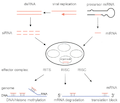Gene silencing facts for kids
Gene silencing is a general term describing epigenetic processes of gene regulation. It is used to describe the "switching off" of a gene by a mechanism other than genetic engineering. That is, a gene which would be expressed ("turned on") under normal circumstances is switched off by machinery in the cell. When a gene is silenced it means that its RNA is unable to make a protein.
Genes are regulated at either the transcriptional stage, or later, before translation.
Transcriptional gene silencing is done by histone modifications, which put heterochromatin around a gene. This means the transcriptional machinery (RNA polymerase, transcription factors, etc.) cannot get at the gene. Genes may be silenced by DNA methylation. This happens regularly during development, when genes are turned on and off at different stages.
Post-transcriptional gene silencing is done by blocking or destroying the mRNA of a particular gene. The destruction of the mRNA prevents translation to form an active gene product (in most cases, a protein). A common way mRNA gets silenced is by RNAi.
Both transcriptional and post-transcriptional gene silencing are used to regulate genes. Methods of gene silencing also protect the organism's genome from transposons and viruses. Gene silencing thus may be part of an ancient immune system protecting cells from such infectious DNA and RNA.
Images for kids
See also
 In Spanish: Silenciamiento génico para niños
In Spanish: Silenciamiento génico para niños





